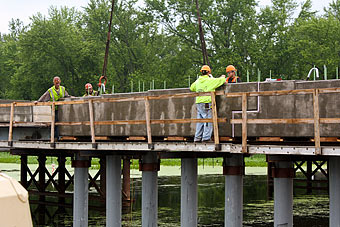UW-Madison engineer lends experience to ambitious bridge-building effort
Remote and virtually undisturbed, the Upper Mississippi River National Wildlife and Fish Refuge boasts a bounty of flora and fauna, both common and rare species that thrive in the largest delta floodplain in the upper Midwest.
At the northern edge of this wilderness, near the confluence of the Chippewa and Mississippi Rivers, is the Nelson-Trevino Bottoms State Natural Area, a 3,740-acre lattice of forested floodplain, marshes, sloughs and ponds.
“Our goal is to build a bridge in a week or two, rather than in three or four months.”
Michael Oliva, professor of civil and environmental engineering
A single main road, Wisconsin Highway 25, bisects the natural area and is the only connection between Wisconsin and Minnesota for 30 miles. For residents of Nelson, Wis., the highway is somewhat of a lifeline: The nearest grocery store is four miles across the river in Wabasha, Minn.
Bridge expert and University of Wisconsin–Madison professor of civil and environmental engineering Michael Oliva is playing an important role in maintaining that link. In 2009, the Wisconsin Department of Transportation (WisDOT) began a $10 million, 15-month project to replace three bridges and rehabilitate another on Highway 25 in the natural area. The project is so crucial that WisDOT received additional funding for it through the federal Highways for Life program.
At nearly two football fields long, the two largest Highway 25 bridges employ precast concrete pier caps and abutments, a substructure that has enabled crews to build the bridge more easily, quickly and safely. Concrete companies “cast” these components off site, in controlled environments. Once the parts cure, trucks haul them to the construction site and bridge-building crews use cranes to drop them into place.

Workers from Lunda Construction set a two-piece precast pier cap into position on the Highway 25 bridge, which bisects the Upper Mississippi River National Wildlife and Fish Refuge.
“Precast concrete components eliminate the need for crews to construct formwork, pour concrete and wait for the concrete to cure before continuing with construction,” says Oliva. “This is particularly beneficial in hard-to-reach locations.”
For several years, Oliva has collaborated with WisDOT engineers and with SpanCrete of Green Bay and County Materials Corp. of Marathon — the only two Wisconsin concrete companies that produce precast bridge components — to develop standards for precast concrete highway bridges. Such bridges could have a 100-year lifetime.
“Professor Oliva’s contributions are his expertise, experience and advice in the field of accelerated and innovative bridge construction techniques,” says Michael Williams, a consultant bridge project engineer with the WisDOT Bureau of Structures in Madison. “WisDOT and Professor Oliva maintain a successful partnership in research projects regarding these techniques in an ongoing effort to construct and maintain our bridges with minimal disruption to the traveling public.”
In 2008, WisDOT first used precast abutments it developed with Oliva and his students in a bridge on Highway 60 near Baldwin, Wis.
Seven-span, 544-foot bridges, the two Highway 25 bridges are the first in the state to use precast concrete pier caps to support the bridge girders. These precast concrete pier caps sit atop groups of piles, vertical cylindrical “poles” that help support the bridge. “The seven-span bridges allowed span lengths where open-pile-bent piers could be used, minimizing the footprint of the piers in the Mississippi River slough and decreasing the time required to construct the piers,” says Williams.
One of the most important aspects of using precast components is connecting them, says Oliva, who has studied connection methods in use worldwide and has developed several of his own. Because of the environmental sensitivity of the Highway 25 bridge project, crews split the precast pier caps in half to minimize their weight and reduce the size of the crane needed to handle them. Placed atop the piles, the halves fit together somewhat like a three-dimensional puzzle, with overlapping “lap-ship” joints skewered, secured with steel pins, and grouted or concreted in place. Steel dowels grouted in place also secure the pier caps to the piles.
Eventually, Oliva hopes his collaboration with WisDOT will yield a bridge that is made up almost entirely of precast components. When that day comes, drivers may rejoice.
“Our goal is to build a bridge in a week or two, rather than in three or four months,” he says.
Enjoy this story?
Read more news from the College of EngineeringSubscribe to Wisconsin Ideas
Want more stories of the Wisconsin Idea in action? Sign-up for our monthly e-newsletter highlighting how Badgers are taking their education and research beyond the boundaries of the classroom to improve lives.
